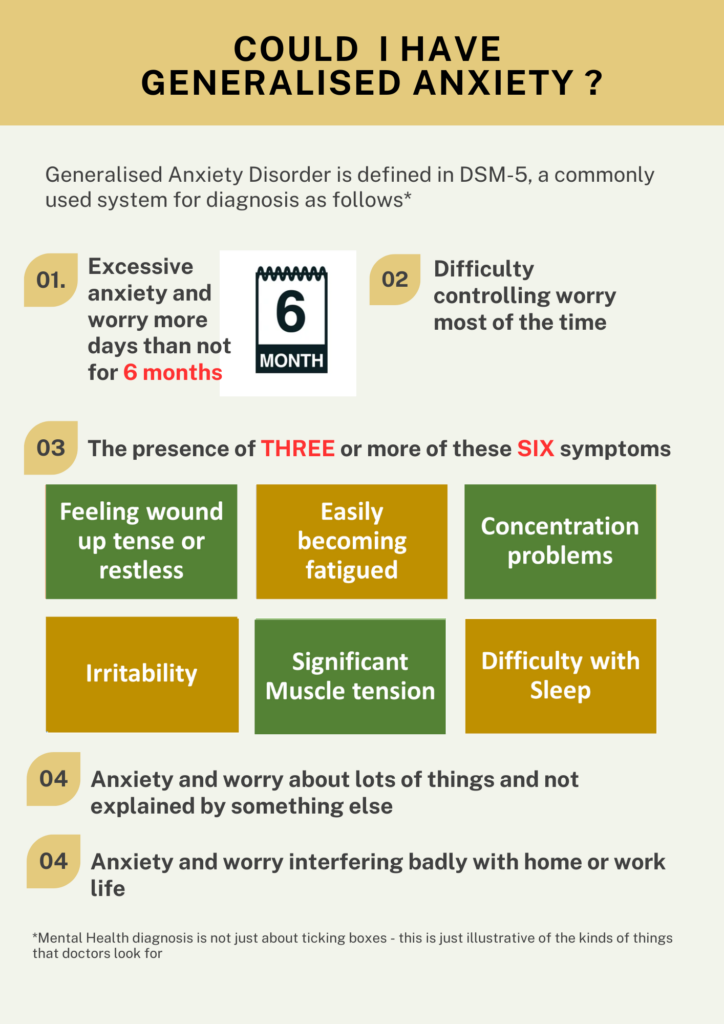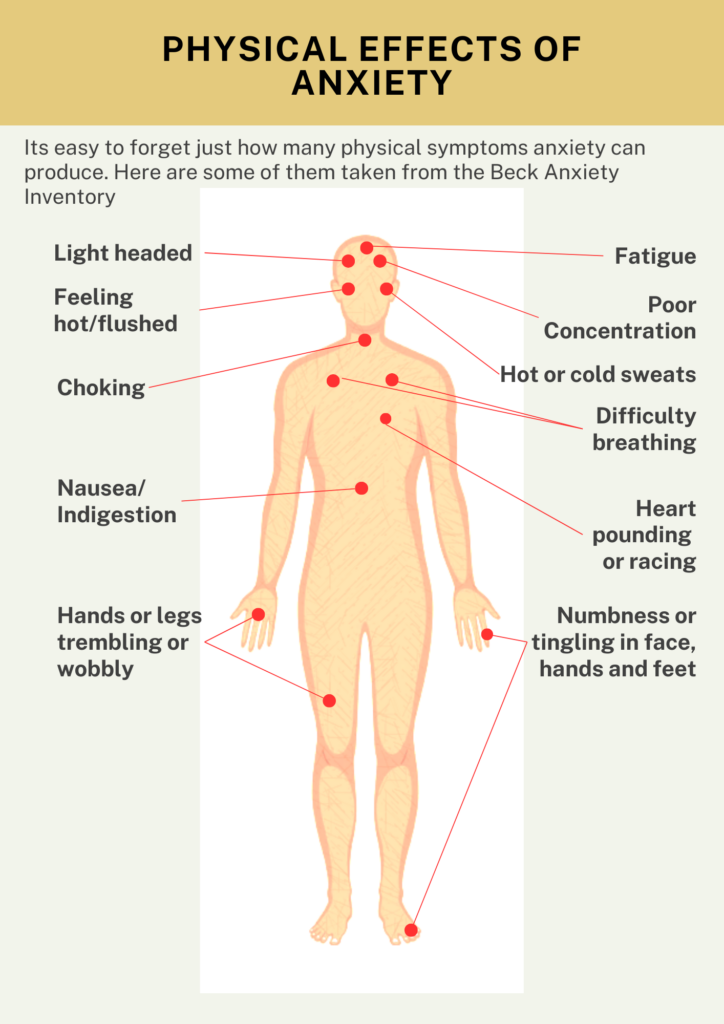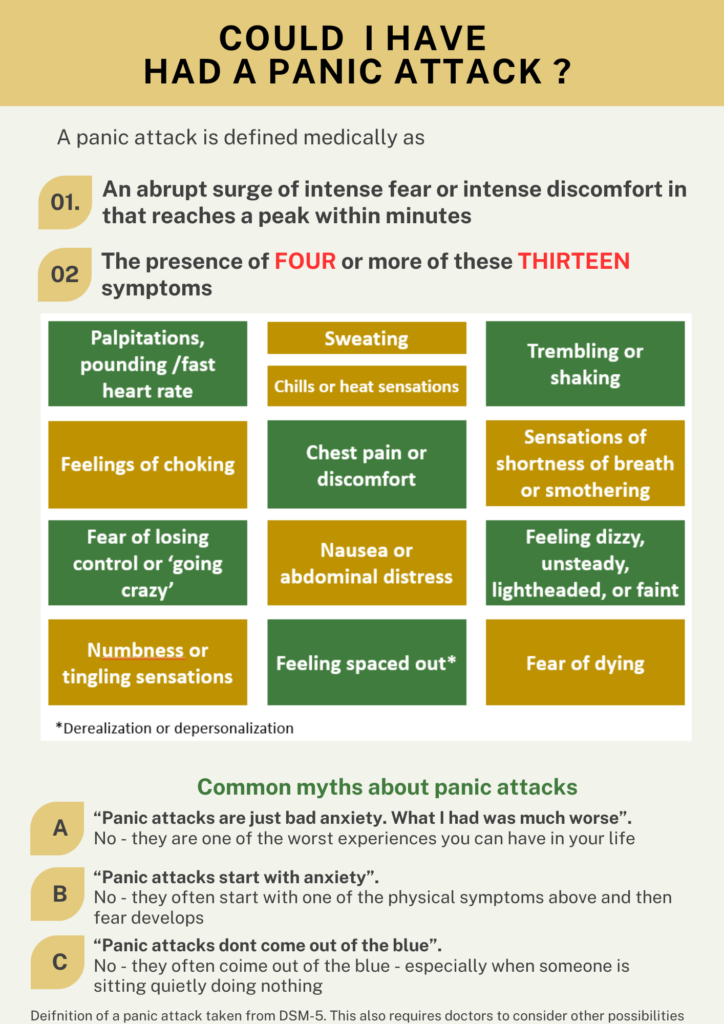Anxiety and panic are common in patients with functional neurological symptoms and FND. However, many patients with these symptoms are not anxious (or depressed)
Anxiety and panic are also very common in Epilepsy and other neurological conditions too,
This website is not designed to cover these symptoms in detail. Some links are provided below
.. Feeling wound-up, tense, or restless, easily becoming fatigued or worn-out, concentration problems, irritability, significant tension in muscles and difficulty with sleep… are all core features of excessive worry or anxiety…
A few things are worth getting straight though in relation to FND:
• If you have anxiety or panic attacks, this does not mean it is the cause of your symptoms. You may feel sensitive when doctors or others ask you how you are feeling, but a good doctor should always ask this, regardless of your diagnosis. For example, patients with multiple sclerosis can suffer from anxiety and depression. When they do, their quality of life is generally not as good so its important to do whatever is possible to improve them. The situation with FND should be no different.
• Admitting to anxiety or panic attacks does not mean you are ‘mental’ / ‘off your head’ / ‘weak willed’ or any of the other things that some people (perhaps even you!) think. There is a lot of stigma out there for these kinds of problems and it is not always easy to deal with.
• The commonest cause of anxiety or worry in patients with functional symptoms is worry about the symptoms themselves. What are they due to? Why doesn’t anyone seem to believe me? Am I going mad? Will I become disabled in the future? Just because the worry is about the symptoms does not mean it isn’t “worry”. Sometimes anxiety about health is an overwhelming problem in itself.
• For some people with FND, Anxiety disorders including panic and PTSD are a major issue and one that needs to be tackled alongside the FND if symptoms are to be understood and treated. There is more on this in the psychological therapy section.
Many patients do not realise what constitutes a diagnosis of anxiety or panic attacks. Here are the widely used criteria for making a diagnosis of these conditions from the American Psychiatric Association (DSM-IV and DSM-5)
Psychiatry and psychology shouldnt be about ‘ticking boxes’. Human beings are more complicated than that. Most mental health professionals only regard these things as a framework.
But I put them her so that you can have a look at the symptoms and decide for yourself whether this an angle worth exploring for you.

A. At least 6 months of “excessive anxiety and worry” about a variety of events and situations. Generally, “excessive” can be interpreted as more than would be expected for a particular situation or event. Most people become anxious over certain things, but the intensity of the anxiety typically corresponds to the situation.
B. There is significant difficulty in controlling the anxiety and worry. If someone has a very difficult struggle to regain control, relax, or cope with the anxiety and worry, then this requirement is met.
C. The presence for most days over the previous six months of 3 or more (only 1 for children) of the following symptoms:
D. The symptoms are not part of another mental disorder.
E. The symptoms cause “clinically significant distress” or problems functioning in daily life. “Clinically significant” is the part that relies on the perspective of the treatment provider. Some people can have many of the aforementioned symptoms and cope with them well enough to maintain a high level of functioning.
F. The condition is not due to a substance or medical issue
Another thing that surprises people is how PHYSICAL the experience of anxiety can be. The picture below shows some common physical symptoms of anxiety. There are of course lots of other causes to these symptoms other than anxiety but it can help to see this list when weighing up explanations that doctors are giving you.

Panic attacks are especially important in many people with FND. People with functional seizures for example often have panic attack-type symptoms leading up to their seizures. When people panic they can also dissociate which means they experience a disconnection from the body or the world around them. Some types of FND motor and sensory symptom begin because that disconnection doesn’t properly recover, for example down one side of the body, even after the panic attack has gone.
When many people first have a panic attack then they often don’t realise that’s what it is. A full-blown panic attack is a terrifying experience that can make you feel you are about to die. Panic attacks commonly start with physical symptoms, not stress or anxiety, and often begin ‘out of the blue’. The list below shows how doctors diagnose a panic attack. It may be helpful for you to decide whether what you had was a panic attack or not.

A) anxiety about being in places or situations from which escape might be difficult (or embarrassing) or in which help may not be available in the event of having an unexpected or situationally predisposed Panic Attack or panic-like symptoms. Agoraphobic fears typically involve characteristic clusters of situations that include being outside the home alone; being in a crowd, or standing in a line; being on a bridge; and traveling in a bus, train, or automobile.
B) The situations are avoided (e.g., travel is restricted) or else are endured with marked distress or with anxiety about having a Panic Attack or panic-like symptoms, or require the presence of a companion.
C) The anxiety or phobic avoidance is not better accounted for by another mental disorder,
The person was exposed to: death, threatened death, actual or threatened serious injury, or actual or threatened sexual violence, in the following way(s):
The traumatic event is persistently re-experienced in the following way(s):
Avoidance of trauma-related stimuli after the trauma, in the following way(s):
Negative thoughts or feelings that began or worsened after the trauma, in the following way(s):
Trauma-related arousal and reactivity that began or worsened after the trauma, in the following way(s):
In addition psychiatrists require that symptoms have been present for at least a month, that the symptoms are causing difficulties for the person and they arent due to another cause.


We will be re-directing you to the University of Edinburgh’s donate page, which enable donations in a secure manner on our behalf. We use donations for keeping the site running and further FND research.
